The bank raid
“The Gringotts that you see in the films was really a ride experience waiting to happen,” says Mark Woodbury, as he explains Universal’s decision to set the headline ride of Diagon Alley in the goblin-run bank.
2001’s Harry Potter and the Sorcerer’s Stone featured scenes of Hagrid taking Harry into the vaults of the bank, travelling deep under the streets of London on a roller coaster-style cart. It didn’t require a huge leap of imagination to foresee that this would provide the ideal inspiration for a theme park attraction. One of the movie’s stars, Rupert Grint, recalls: “Even when we were filming it, we always used to say ‘this would make a really good ride.’”
Whereas Harry Potter and the Forbidden Journey’s storyline had been a “greatest hits” of sorts, taking guests on a journey through a variety of recognizable locations and moments from the movies and books, the follow-up – dubbed Harry Potter and the Escape from Gringotts – would focus on a much more specific set of events, and would largely take place in a single venue. “The story part of it was really important to us,” explains Woodbury. “[We wanted] to bring people into that moment in time in the fiction when Harry, Ron and Hermione are breaking into Gringotts Bank.” This sequence appeared in the final movie in the series, Harry Potter and the Deathly Hallows – Part 2, as the trio sought to recover one of the “horcruxes” created by the evil Lord Voldemort in an attempt to attain eternal life.
The challenge was to find a way to place guests in the thick of the action, without breaking the continuity of the original story. “It took a lot of thought and consideration to find a way to allow us to be in that moment from the movie,” recalls Woodbury. “We had to find a window that would put us right into the middle of that. But it was a tricky piece of business to find a way to do that and have it be authentic. We studied it pretty hard and the thing we came up with was a slice of time by which we would be able to be in Gringotts Bank at the moment Harry, Ron and Hermione were breaking in.”
“Certain things happen that may not be described in the book,” says Thierry Coup. “Collaborating with J.K. Rowling and her vision allowed us to create that experience – that’s the only way that could have happened.”
Whereas Harry Potter and the Forbidden Journey had focused largely on Harry and his friends, the stars of the new ride would be two of his darkest enemies: Lord Voldemort and Bellatrix Lestrange. Ralph Fiennes and Helena Bonham Carter would return to reprise the roles that they played in the movies.
“Having Helena and Ralph as part of this movie and ride film was really extraordinary,” claims Woodbury. “They are just extraordinary acting talents. Thierry directed them, and seeing them in character and in costume on the set and watching them bring these characters to life was a tremendous experience – to be sitting next to somebody, and suddenly see them explode into character. You learn to appreciate the genius you are surrounded by.”
Harry Potter and the Escape from Gringotts would occupy a huge portion of the new Wizarding World, though it would be largely hidden inside a cavernous show building. As with Harry Potter and the Forbidden Journey, the queue line would form a major part of the overall experience.
“[The entry] is a giant marble room. It’s enormous, with huge chandeliers. We have animatronic goblins that are working in the bank, processing payments from various muggles who are allowed in that day,” explains Alan Gilmore.
The goblins would play a major role in the queue line, and Eric Hunt, the Creative Producer for the attraction, is particularly proud of them. “This is unlike anything that’s out there,” he boasts. “It’s a major achievement for Universal, because it’s not something you’ve seen in many parts of our parks throughout the world. This is the only place where we have animation at this capacity, where it’s really up close and personal and you can see all the detailing. And what’s great about the details is that the accuracy is coming right off the digital models from the feature films, so they are so authentic.”
The areas occupied by the goblins and passed through by guests would be either based directly on or inspired by the look and feel of the Gringotts sets seen in the movies. “Stuart Craig [the movies' Production Designer] takes his vision from the feature films, and that segways into drawings that we use to create the environments [for the theme park],” explains Hunt. “Similar, but different because we have to be able to accommodate two or three thousand guests per hour – certainly different to building a set that’s only going to be used for a shoot.”
Once they had descended into the vaults, guests would board mine cart-themed vehicles before racing off on their adventure. As it had with the Amazing Adventures of Spider-Man and its first Harry Potter ride, Universal would build on its previous successes when devising the ride system for Harry Potter and the Escape from Gringotts. “The ride system for Gringotts is a combination of all the great ride systems we have done in the past,” says Coup, “but combined together with control systems that were not fast enough years ago.”
An essential element of the experience would be the ride’s unique vehicles. Nine trains would be made up of two 12-seater cars each, with lap bars holding guests in place. The vehicles would include a turntable that would sit on top of the chassis, enabling the guests to be spun in any direction, in a similar fashion to the ride vehicles employed by The Cat in the Hat and Men in Black: Alien Attack. Although the trains would coast down sections of the track as on a traditional roller coaster, for much of the circuit their movement would be controlled by rotating tires distributed along the ride path.
Rather than being a simple, linear journey, the Gringotts ride experience would incorporate some unique set pieces and transitions. The first of these would be a piece of tilting track, situated in front of a projection screen that would hold riders’ attention. The track would pivot around a center point, sending the rear car up into the air while the front car leaned precipitously forward. After a few moments, the train would be released, plunging down the ride’s longest drop.
Another section would see a portion of track mounted onto a motion base, seemingly based on a patent filed by Universal in 2011. In a sequence similar to the “roof plunge” segment at the end of the Amazing Adventures of Spider-Man, the motion track would be used in conjunction with footage on a projection screen to simulate a long freefall, with guests coming under attack from a troll.
In common with most of Universal’s recent high-profile rides, projection screens would play a major role in Harry Potter and the Escape from Gringotts. The ride would employ 4K digital high definition 3-D projection systems supplied by Infitec, with guests donning 3-D glasses.
“The optics are so much better [from the new projection systems],” says Coup. “We have no more ghosting effect, we have really sharp imagery that gives you much more depth, no more strobing on the imagery. We have much bigger screens than we did before. We can also do edge blending, which is a technique that allows us to use almost 360-degree screens that immerse you into the imagery, so you feel you are there with your favorite actors – not just for 10-15 seconds, but for 30-40 seconds at a time.”
In total, some 17,000 square feet of projection surfaces would be used within the Gringotts attraction. The screens were built by Winter Garden, Florida-based Phoenix Rising, with the largest being 110 feet in circumference, 45 feet high and with a vertical and horizontal radius of nearly 55 feet. The surfaces are coated with Goo Systems Global’s Screen Goo, a specially formulated, highly-reflective acrylic paint that allows any smooth paintable surface to be transformed into a high performance projection screen.
Filling the enormous screens is a task that is beyond even modern high-definition projectors. Instead, a number of projectors are combined together in order to increase the total resolution of the image. The images from the different projectors are overlapped, with the images being visually joined together using edge blending. This technique involves varying the brightness of the overlapping image regions in order to ensure that they appear to be a single, seamless image to those viewing them.
The roller coaster-based ride system employed by Harry Potter and the Escape from Gringotts would differ significantly from the robotic arms used by Forbidden Journey. However, one of the robotic arms would play a key role towards the end of the new attraction. As Harry Potter fought a pitched battle with Voldemort on a huge projection screen, fog effects would obscure the arm, which would move a portion of the screen to enable riders’ vehicles to slip through it.
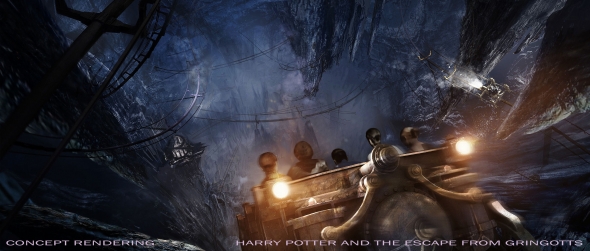
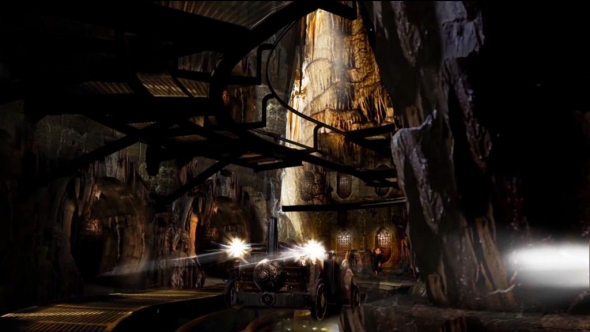
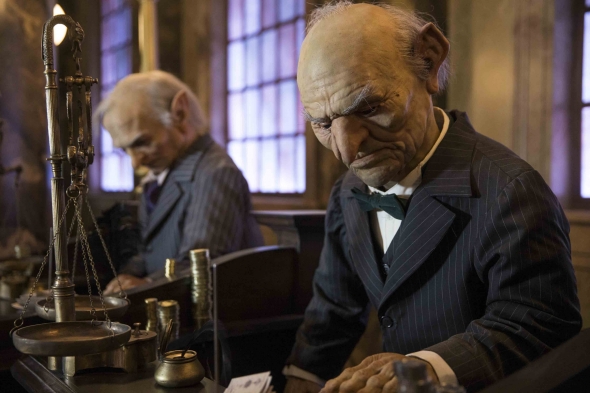
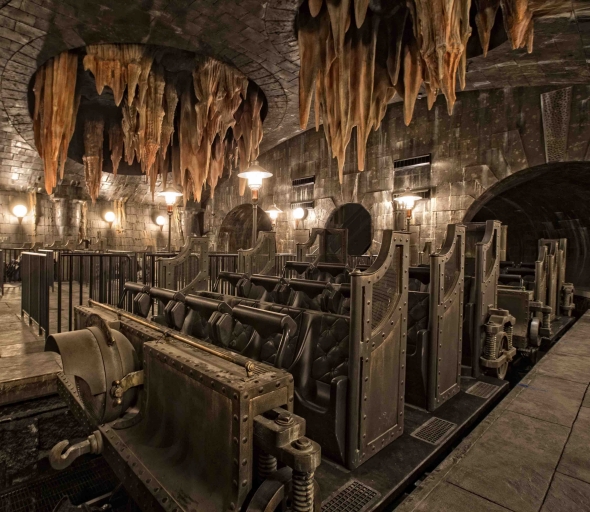
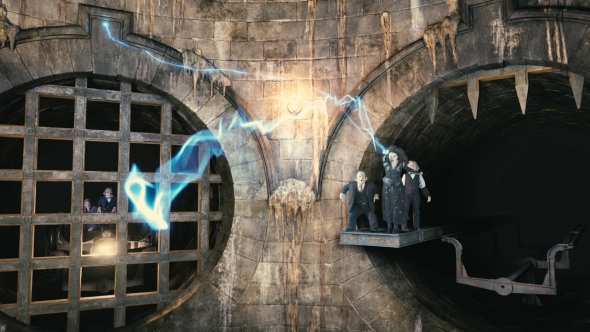
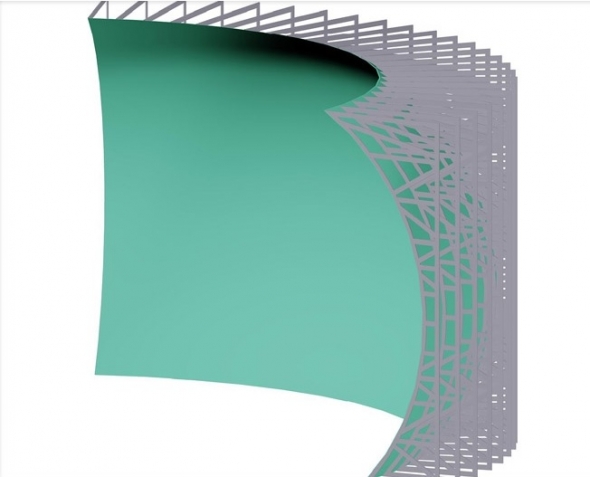
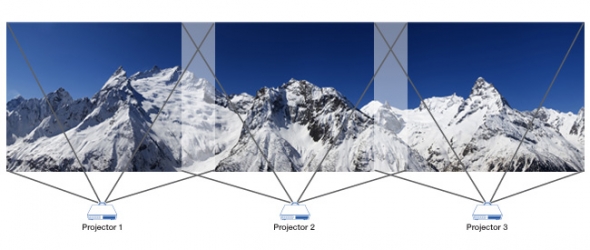

Comments
This is an amazing article. I live in Orlando, and have been to US and IOA since they opened. I learned things I didn't know! Thanks for all the insider info!